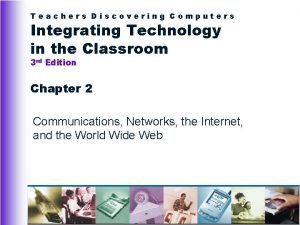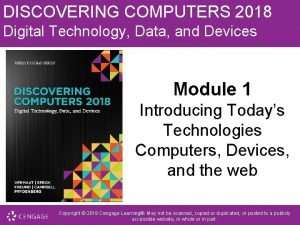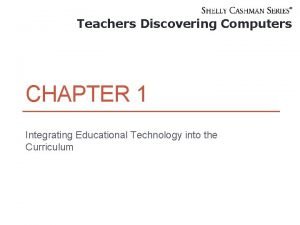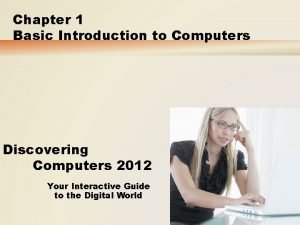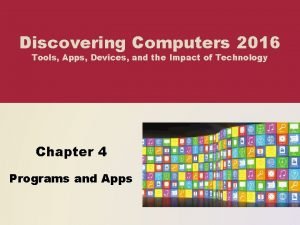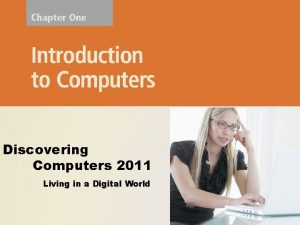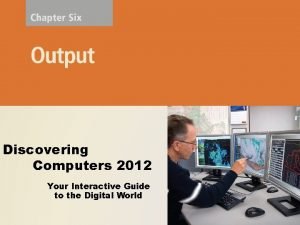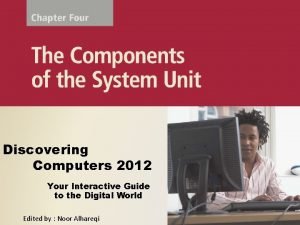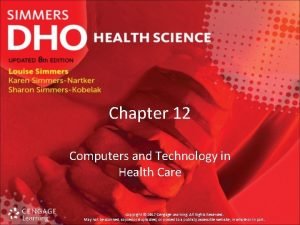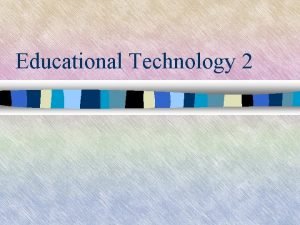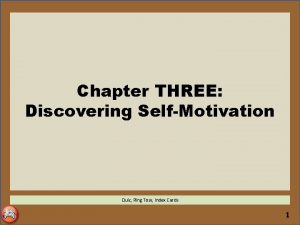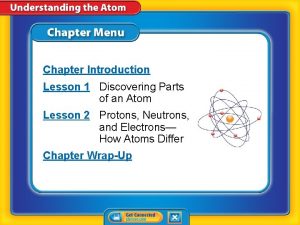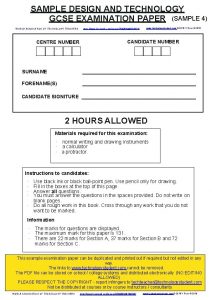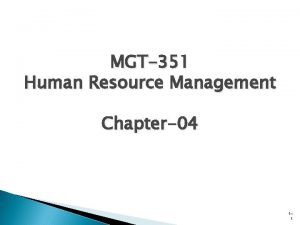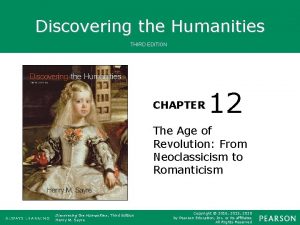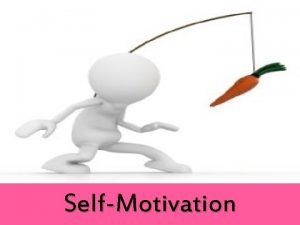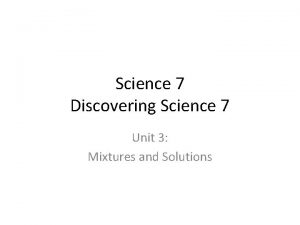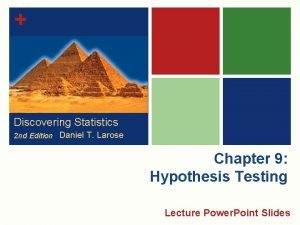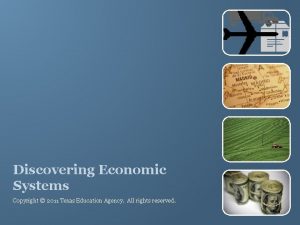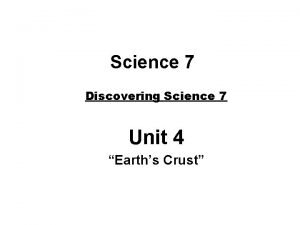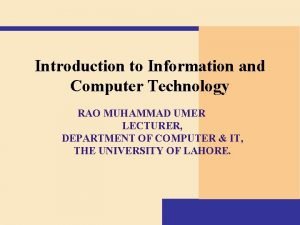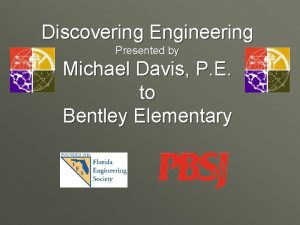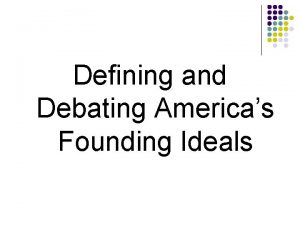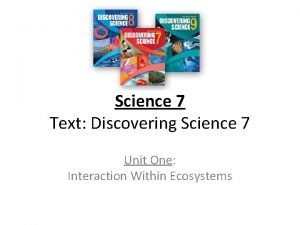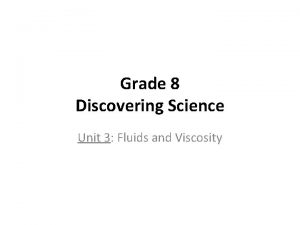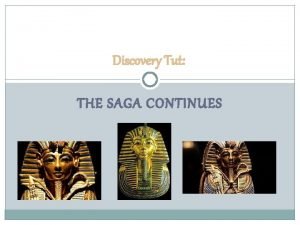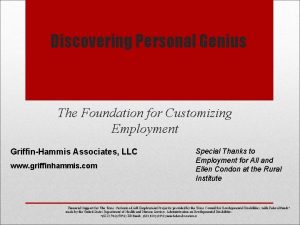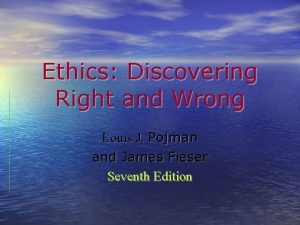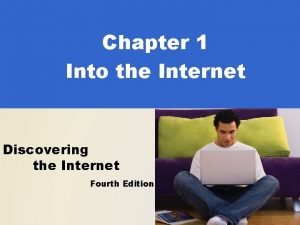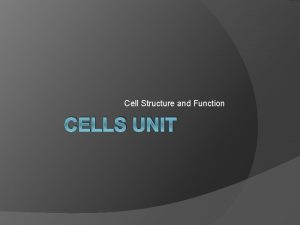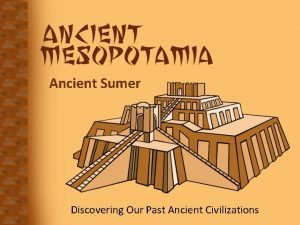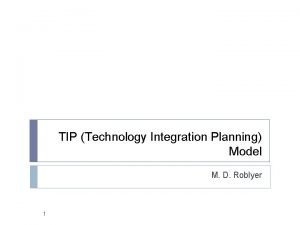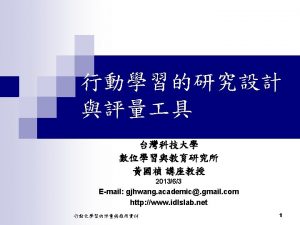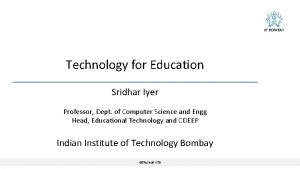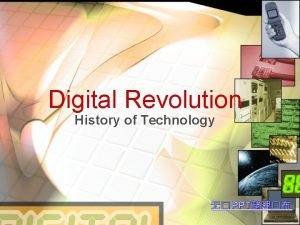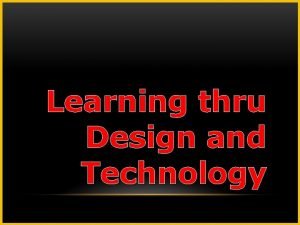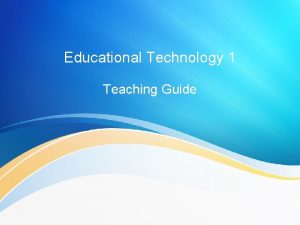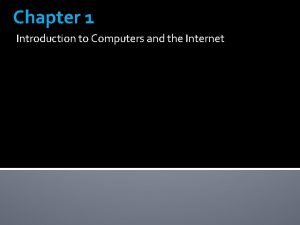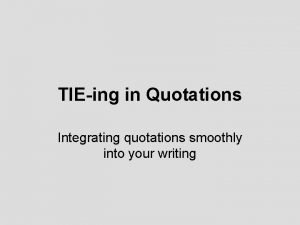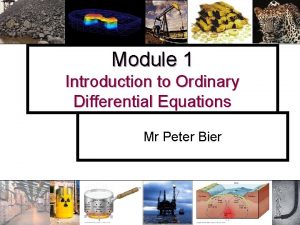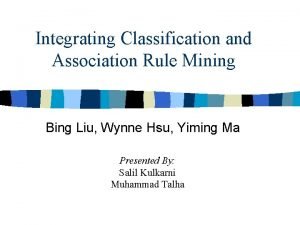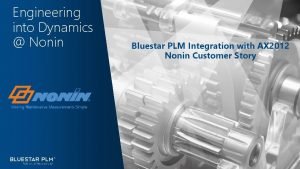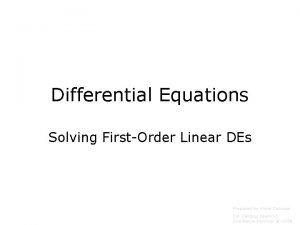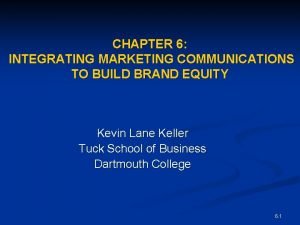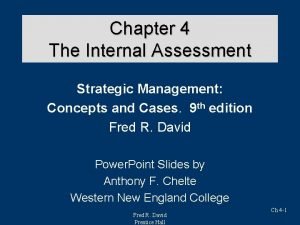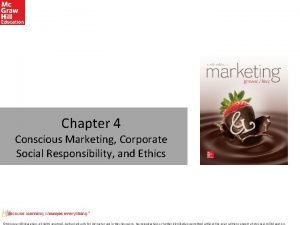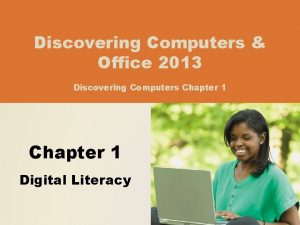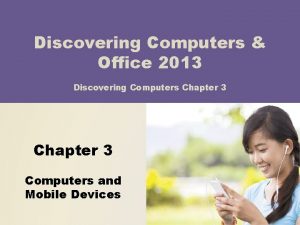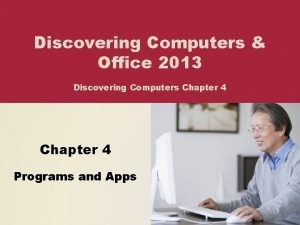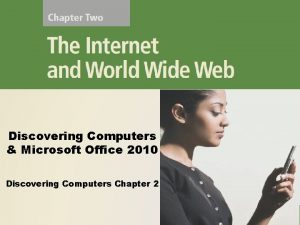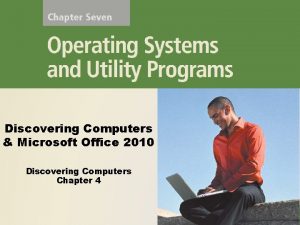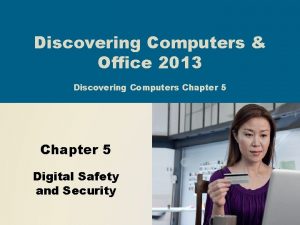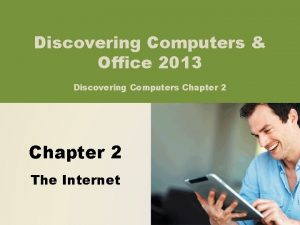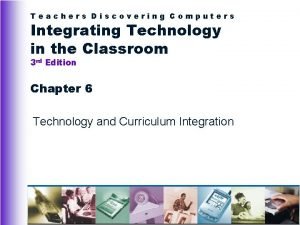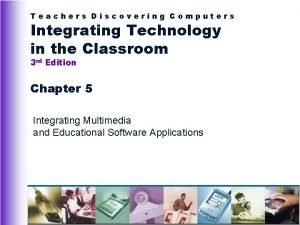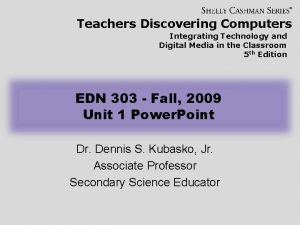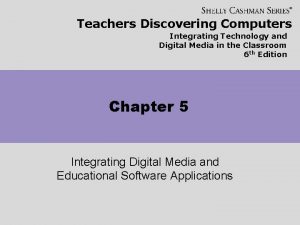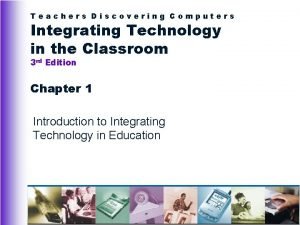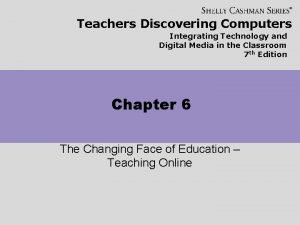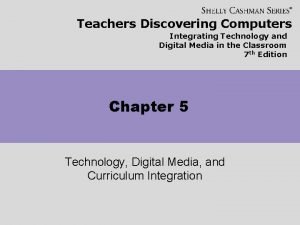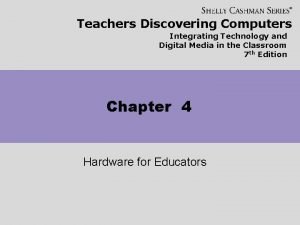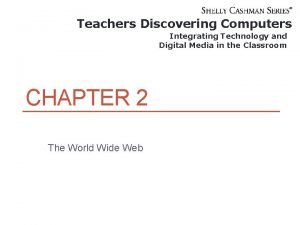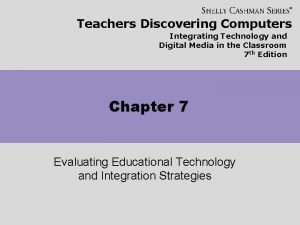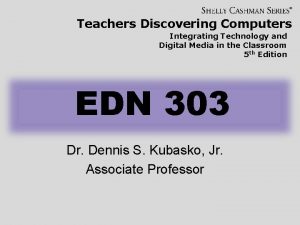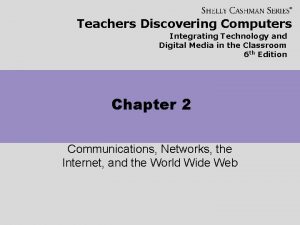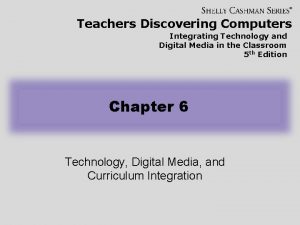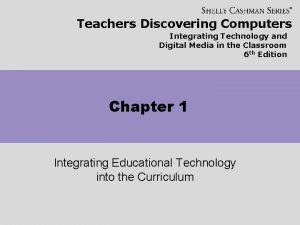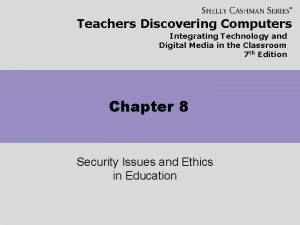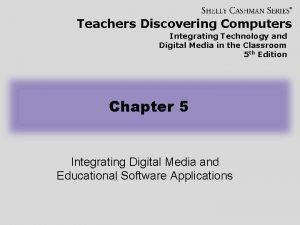Teachers Discovering Computers CHAPTER 1 Integrating Educational Technology






















































- Slides: 54

Teachers Discovering Computers CHAPTER 1 Integrating Educational Technology into the Curriculum

Chapter Objectives • Define curriculum-specific learning • Explain the difference between computer, information, and integration literacy • Explain why it is necessary to change instructional strategies from traditional to new learning environments • Describe the evolution of computers and digital media • Differentiate among the various categories of computers • Explain why computer technology and digital media are important for education

Chapter Objectives • Describe the National Educational Technology Standards for Teachers (NETS-T) and Students (NETS-S) • Explain why 21 st century skills need to be incorporated in K-12 curriculum • Describe the characteristics of today’s digital students • Describe six categories of what today’s students need to know • Provide examples of how computers are changing the way people teach and learn • Describe why it is so important for every teacher to have a current e. Portfolio

Curriculum-Specific Learning • Three ways you can use the knowledge you acquired • For your own professional development, • For using technology as a productivity tool in your classroom, • For extensively integrating technology, mobile devices, and digital media into your • instructional strategies • Lessons • student-based projects • student assessments • To improve student learning Chapter 1: Integrating Educational Technology into the Curriculum 4

Curriculum-Specific Learning (cont) Traditional Learning Environments New Learning Environments Teacher- centered instruction Student- centered learning Single- sense stimulation Multisensory stimulation Single- path progression Multipath progression Single media Multimedia Isolated work Collaborative work Information delivery Information exchange Passive learning Active/ exploratory/ inquiry- based learning Factual, knowledge- based learning Critical thinking and informed decision making Reactive response Proactive/ planned action Isolated, artificial context Authentic, real- world context Chapter 1: Integrating Educational Technology into the Curriculum 5

Computer, Information, and Integration Literacy • Computer literacy • Knowledge and understanding of computers and their uses • Information literacy • Knowing how to find, analyze, and communicate information • Integration literacy • The ability to use computers, mobile devices, digital media, and other technologies combined with a variety of teaching and learning strategies to enhance students’ learning Chapter 1: Integrating Educational Technology into the Curriculum 6

7 Computer, Information, and Integration Literacy • Computer technology, digital media, and mobile devices are present in every aspect of daily living • in the workplace • at home • in the classroom • ued for entertainment

What Is a Computer and What Does It Do? • An electronic device, operating under the control of instructions stored in its memory, that can accept data, process the data according to specified rules, produce results, and store the results for future use • A computer is a computational device Chapter 1: Integrating Educational Technology into the Curriculum 8

What Is a Computer and What Does It Do? • Data - collection of unorganized facts • Information - data that is organized, meaningful, and useful • Input - data entered into a computer • Output - processed results from a computer Chapter 1: Integrating Educational Technology into the Curriculum 9

What Is a Computer and What Does It Do? • The four primary operations of a computer are: • Input Data • Process • Output Information • Store Data • Known as the information processing cycle.

What Is a Computer and What Does It Do? • A user inputs data into a computer, and the computer processes it. • When data is processed, into a meaningful or useful form, it becomes information. • Data that is not meaningful or useful after process is know by the term Garbage In Grabage Out (GIGO).

What Is a Computer and What Does It Do? • Storage – holding data and information for future use • Information processing cycle – the cycle of input, process, output, and storage • Hardware – the electronic and mechanical equipment that makes up the computer • Software – a series of instructions that tells the hardware how to perform tasks Chapter 1: Integrating Educational Technology into the Curriculum 12

The Evolution of Computers and Digital Media • Before 1946: Precomputers and Early Computers

The Evolution of Computers and Digital Media • Approx. 1946 -1957: First-Generation Computers • Large room sized • Used paper puch cards and tapes • UNIVAC was the first mass produced computer.

CMPTR Chapter 1: Introduction to Computers and the Internet The Evolution of Computers and Digital Media • 1958 -1963: Second-Generation Computers – IBM 1401

CMPTR Chapter 1: Introduction to Computers and the Internet The Evolution of Computers and Digital Media • 1964 -1970: Third-Generation Computers – IBM/System 360 IC’s

The Evolution of Computers and Digital Media • Approx. 1971 - Present: Fourth. Generation Computers • Introduction of the CPU Apple IBM 5150 Macintosh

The Evolution of Computers and Digital Media • The first decade of the 21 st century was known as the age of • • convergence. Convergence is merging the various forms of communications ( the telephone, television, and computers) into effective, interactive, mobile devices. This age of convergence will continue to evolve in new, exciting ways Today’s personal computer and mobile device architectures take advantage of a computer’s individual power, digital media capabilities, and the ability to be interconnected with others in networked environments, also known as social networking. As a result, multimedia technology systems have become increasingly more powerful and better able to handle information rich Chapter in visual and aural content. 18 1: Integrating Educational Technology into the Curriculum

The Evolution of Computers and Digital Media • The goal of multimedia computing and communications is to assist individuals in organizing and managing vast amounts of information in various types of media • Digital media – technologies that allow users to create new forms of interaction, expression, communication, and entertainment in a digital format Chapter 1: Integrating Educational Technology into the Curriculum 19

Categories of Computers • Personal computers • Mobile computers and mobile devices • Game consoles • Servers, supercomputers, and embedded computers Chapter 1: Integrating Educational Technology into the Curriculum 20

Personal Computers • Personal computers also called desktop computers are designed so the system unit, input devices, output devices, and any other devices fit entirely on a desk. • A personal computer has the capability to perform input, processing, output, and storage activities. Chapter 1: Integrating Educational Technology into the Curriculum 21

Mobile Computers and Mobile Devices • Mobile Computers • Notebook computer • Tablet computer • Netbook • Mobile Devices • Smartphone • E-book reader Chapter 1: Integrating Educational Technology into the Curriculum 22

Game Consoles • Computing device designed for single player or multiplayer video games • Controller is the input device on standard game consoles • Television is the output device • Hard Disks, optical discs, and memory cards are used for storage Chapter 1: Integrating Educational Technology into the Curriculum 23

Midrange Servers • A midrange server (sometimes called a minicomputer) is a medium-sized computer used to host programs and data for a small network. • One trend involving midrange servers, as well as the mainframe computers, is virtualization.

Mainframe Computers • A mainframe computer is a powerful computer used in many large organizations that need to manage large amounts of centralized data.

Supercomputers • Supercomputers are the most powerful and most expensive type of computer available. • To reduce the cost, supercomputers are often built by connecting hundreds of smaller and less expensive computers into a supercomputing cluster that acts as a single supercomputer.

Embedded Computers • An embedded computer is a tiny computer embedded into a product designed to perform specific tasks or functions for that product. • Used in appliances.

Why Use Computer Technology in Education? • Technology and digital media are everywhere • Technology can support learning • Computers support communications beyond classroom walls • Support of national and international organizations Chapter 1: Integrating Educational Technology into the Curriculum 28

International Society for Technology in Education ( ISTE), • On of the leading nonprofit group that promotes the use of technology to support and improve teaching and learning. • ISTE has been instrumental in developing the National Educational Technology Standards ( NETS) for the National Council for Accreditation for Teacher Education ( NCATE). • NCATE is the official body for accrediting teacher education programs. • ISTE has developed standards for K- 12 teachers, school administrators, and students. Chapter 1: Integrating Educational Technology into the Curriculum 29

International Society for Technology in Education ( ISTE), • Web address for ISTE http: //www. iste. org/welcome. aspx. • Web address for NCATE http: //www. ncate. org/ Chapter 1: Integrating Educational Technology into the Curriculum 30

The World Is Flat • In his books, The World Is Flat and Hot, Flat, and Crowded, Thomas Friedman describes how “ lightningswift changes in technology and communications put people all over the globe in touch with each other as never before • Friedman and others stress that many young people are not prepared to be successful in a global economy, which in turn is impacting how America competes on the world stage. • The web address for the Flat Classroom Projects is http: //www. flatclassroomproject. org/ Chapter 1: Integrating Educational Technology into the Curriculum 31

21 st Century Skills • The Partnership for 21 st Century Skills is a national organization that focuses on infusing 21 st century skills into education • The partnership’s goal is to ensure that students who graduate from our schools have the skills needed to be effective workers, citizens, and leaders in the new global economy. • The web address for the partnership is http: //www. p 21. org/ Chapter 1: Integrating Educational Technology into the Curriculum 32

21 st Century Skills Chapter 1: Integrating Educational Technology into the Curriculum 33

Computing in the Digital Age • Digital Students: Who are they and how do they learn? • Digital generations - students use different technologies to communicate and to access information from multiple resources • Digital students (digital kids) • Hypercommunicators • Multitaskers • Goal oriented Chapter 1: Integrating Educational Technology into the Curriculum 34

Computing in the Digital Age • Creativity and Innovation - Students demonstrate creative thinking, construct knowledge, and develop innovative products and processes using technology. • apply existing knowledge to generate new ideas, products, or processes. • create original works as a means of personal or group expression. • use models and simulations to explore complex systems and issues. • identify trends and forecast possibilities Original information found on www. iste. org website Chapter 1: Integrating Educational Technology into the Curriculum 35

Computing in the Digital Age • Gamemaker is an example of a software program that allows students to create video games while fostering opportunities for creativity and innovation Chapter 1: Integrating Educational Technology into the Curriculum 36

Computing in the Digital Age • Communication and Collaboration - Students use digital media and environments to communicate and work collaboratively, including at a distance, to support individual learning and contribute to the learning of others. Students: • interact, collaborate, and publish with peers, experts, or others employing a variety of digital environments and media. • communicate information and ideas effectively to multiple audiences using a variety of media and formats. • develop cultural understanding and global awareness by engaging with learners of other cultures. • contribute to project teams to produce original works or solve problems. Original information found on http: //www. iste. org/welcome. aspx website Chapter 1: Integrating Educational Technology into the Curriculum 37

Computing in the Digital Age • Research and Information Fluency - Information fluency is when a person has mastered the ability to analyze and evaluate information • Students apply digital tools to gather, evaluate, and use information. Students: • plan strategies to guide inquiry. • locate, organize, analyze, evaluate, synthesize, and ethically use information from a variety of sources and media. • evaluate and select information sources and digital tools based on the appropriateness to specific tasks. • process data and report results. Original information found on http: //www. iste. org/welcome. aspx website Chapter 1: Integrating Educational Technology into the Curriculum 38

Computing in the Digital Age • Critical Thinking, Problem Solving, and Decision Making - Students use critical thinking skills to plan and conduct research, manage projects, solve problems, and make informed decisions using appropriate digital tools and resources. Students: • identify and define authentic problems and significant questions for investigation. • plan and manage activities to develop a solution or complete a project. • collect and analyze data to identify solutions and/ or make informed decisions. • use multiple processes and diverse perspectives to explore alternative solutions. Original information found on http: //www. iste. org/welcome. aspx website Chapter 1: Integrating Educational Technology into the Curriculum 39

Computing in the Digital Age • Digital Citizenship - students understand human, cultural, and societal issues related to technology and practice legal and ethical behavior. Students: • advocate and practice safe, legal, and responsible use of information and technology. • exhibit a positive attitude toward using technology that supports collaboration, learning, and productivity. • demonstrate personal responsibility for lifelong learning. d. exhibit leadership for digital citizenship. Original information found on http: //www. iste. org/welcome. aspx website Chapter 1: Integrating Educational Technology into the Curriculum 40

Computing in the Digital Age • Technology Operations and Conceptss - Students demonstrate a sound understanding of technology concepts, systems, and operations. Students: • understand use technology systems. • select and use applications effectively and productively. • troubleshoot systems and applications. • transfer current knowledge to learning of new technologies. Original information found on http: //www. iste. org/welcome. aspx website Chapter 1: Integrating Educational Technology into the Curriculum 41

Computing in the Digital Age • ARCS motivational model • Developed in 1983 and applicable to learning in the digital age Chapter 1: Integrating Educational Technology into the Curriculum 42

Computing in the Digital Age • Attention - Lessons are designed to gain students’ attention using alternative techniques, such as a story, sensory stimuli, thought- provoking questions, and variability in exercises, and using digital media. • Relevance - Students see relevance in the lesson, which, in turn, leads to increased learning. The lesson must be relevant not only to the learner, but also to previously taught lessons. Chapter 1: Integrating Educational Technology into the Curriculum 43

Computing in the Digital Age • Challenge/Confidence - Students are challenged to achieve, and they gain confidence as they meet the challenge. Students need to feel that if they put in a good faith effort, they are capable of achieving the objectives. The challenge should properly match the students’ abilities. • Satisfaction/Success - Students gain success in achieving their objective, which promotes self- satisfaction from the learning experience. The most powerful reward is that the students find that the learning experience is relevant and useful to their own world or the one they aspire to live and work in. Chapter 1: Integrating Educational Technology into the Curriculum 44

Creating a Professional Teaching Portfolio • One tool that will set you apart from the crowd • Highlight your instructional credentials and provide a sampling of your work • Detailing your accomplishments • Showcasing your development of content-specific standards-based lessons • Keep up to date Chapter 1: Integrating Educational Technology into the Curriculum 45

What Is a Professional Teaching Portfolio? • A professional teaching portfolio, also known as an e. Portfolio, e-Portfolio, or e. Folio, is a collection of evidence to document your development and growth in the teaching profession • Includes materials and artifacts to document or provide evidence of your education, background, philosophy, teaching strategies, experience in teaching, lesson plans, your personal achievements, and more • The emergence of virtual learning environments (VLEs) in K-12 schools and universities has led to an increased rationale for e. Portfolios Chapter 1: Integrating Educational Technology into the Curriculum 46

What Is a Professional Teaching Portfolio? • You probably will use the materials in your e. Portfolio for multiple purposes and for different audiences, so it is very important that your collection of digital evidence be current and accurately reflect you Chapter 1: Integrating Educational Technology into the Curriculum 47

What Should Be Included in Your e. Portfolio? • Philosophy of education • Resume • Reflective essays • Presentations • Research papers • Images • Videos • Projects • Reports • Lesson samples • Letters from students, instructors, and feedback from others Chapter 1: Integrating Educational Technology into the Curriculum 48

Where Should I Store My e. Portfolio • Many are maintained within a university’s VLE • Live. Text is a flexible management system that provides institutions of higher learning with advanced and userfriendly Web-based tools for developing, assessing, and measuring student learning and more • Create more than one backup of your e. Portfolio by saving your materials to another medium, such as your hard drive or a flash drive or both • Keep backups in different locations Chapter 1: Integrating Educational Technology into the Curriculum 49

Impact of Smartphones, Tablet Computers, and Apps on Education • Many experts are predicting that in the near future every student in the United States and the majority of students in many other countries will be using an array of mobile devices • Your students’ tablet computers will be loaded with digital textbooks, interactive textbook apps, social media apps, and an array of inexpensive curriculum- and gradespecific education apps and games • To be competitive in our changing flattening world, our future leaders and workers must be prepared to utilize current and emerging technologies Chapter 1: Integrating Educational Technology into the Curriculum 50

51 The Digital Divide • The Digital Divide, or the digital split, is a social issue referring to the differing amount of information between those who have access to the Internet (specially broadband access) and those who do not have access. • Broadly speaking, the difference is not necessarily determined by the access to the Internet, but by access to ICT (Information and Communications Technologies) and to Media that the different segments of society can use. • With regards to the Internet, the access is only one aspect, other factors such as the quality of connection and related services should be considered. • Today the most discussed issue is the availability of the access at an affordable cost.

52 The Digital Divide • The disadvantage can take such forms as • lower-performance computers • lower-quality or high price connections (i. e. narrowband or dialup connection) • difficulty of obtaining technical assistance • lower access to subscription-based contents.

Chapter Summary • Define curriculum-specific learning • Explain the difference between computer, information, and integration literacy • Explain why it is necessary to change instructional strategies from traditional to new learning environments • Describe the evolution of computers and digital media • Differentiate among the various categories of computers • Explain why computer technology and digital media are important for education Chapter 1: Integrating Educational Technology into the Curriculum 53

Chapter Summary • Describe the National Educational Technology Standards for Teachers (NETS-T) and Students (NETS-S) • Explain why 21 st century skills need to be incorporated in K-12 curriculum • Describe the characteristics of today’s digital students • Describe six categories of what today’s students need to know • Provide examples of how computers are changing the way people teach and learn • Describe why it is so important for every teacher to have a current e. Portfolio Chapter 1: Integrating Educational Technology into the Curriculum 54
 Teachers discovering computers
Teachers discovering computers Discovering computers 2018 ppt
Discovering computers 2018 ppt Discovering computers 2018 chapter 1
Discovering computers 2018 chapter 1 Discovering computer
Discovering computer Discovering computers 2016
Discovering computers 2016 Discovering computers 2011
Discovering computers 2011 Tactile output device
Tactile output device The system generates regular electronic pulses
The system generates regular electronic pulses Chapter 12 computer and technology in health care
Chapter 12 computer and technology in health care Middle level integration
Middle level integration Kim kroll
Kim kroll Chapter 3 discovering self motivation quiz
Chapter 3 discovering self motivation quiz Chapter 7 lesson 1 discovering parts of an atom answer key
Chapter 7 lesson 1 discovering parts of an atom answer key Sample design and technology gcse examination paper answers
Sample design and technology gcse examination paper answers Job analysis information
Job analysis information Discovering the humanities 4th edition
Discovering the humanities 4th edition What is self motivation
What is self motivation Pure substances
Pure substances P value in statistics
P value in statistics Discovering economic systems guided practice
Discovering economic systems guided practice Discovering science 7
Discovering science 7 Muhammad computer technology
Muhammad computer technology Discovering engineering
Discovering engineering Discovering american ideals in primary sources
Discovering american ideals in primary sources Discovering science 7
Discovering science 7 Density particles
Density particles A r williams author of discovering tut
A r williams author of discovering tut Discovering personal genius
Discovering personal genius Ethics discovering right and wrong
Ethics discovering right and wrong Discovering the internet
Discovering the internet Discovering cells
Discovering cells Discovering our past ancient civilizations
Discovering our past ancient civilizations Tip model
Tip model Ancova table
Ancova table Educational technology interoperability
Educational technology interoperability Sridhar iyer iit bombay
Sridhar iyer iit bombay Digital revolution ppt
Digital revolution ppt Logia meaning in education
Logia meaning in education Learning through design and technology
Learning through design and technology Meaning of educational technology
Meaning of educational technology Chapter 1 introduction to computers and programming
Chapter 1 introduction to computers and programming Chapter 1 introduction to computers and programming
Chapter 1 introduction to computers and programming Computer oriented society
Computer oriented society Chapter 1 introduction to computers and programming
Chapter 1 introduction to computers and programming C programming chapter 1
C programming chapter 1 Direct quote
Direct quote Embedded quotes mla examples
Embedded quotes mla examples Depolarization
Depolarization Integrating factor method
Integrating factor method Integrating classification and association rule mining
Integrating classification and association rule mining Plm dynamics 365
Plm dynamics 365 Intergrating factor
Intergrating factor Integrating marketing communication to build brand equity
Integrating marketing communication to build brand equity Exemplifies the complexity of relationships
Exemplifies the complexity of relationships 4 principles of conscious marketing
4 principles of conscious marketing
